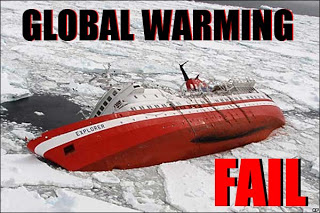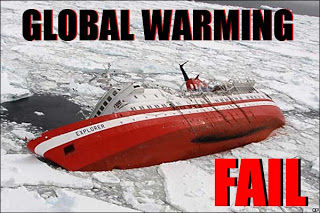By Doug L. Hoffman

For decades, the supporters of CO2 driven global warming have discounted changes in solar irradiance as far too small to cause significant climate change. Though the Sun’s output varies by less than a tenth of a percent in magnitude during its 11-year sunspot cycle, that small variation produces changes in sea surface temperatures two or three times as large as it should. A new study in
Science demonstrates how two previously known mechanisms acting together amplify the Sun’s impact in an unsuspected way. Not surprisingly, the new discovery is getting a cool reception from the CO2 climate change clique. Scientists have long suspected that changes in solar output may have triggered the Little Ice Age that gripped Europe several centuries ago, as well as droughts that brought down Chinese dynasties. Now, in a report in the August 28 issue of the journal
Science entitled “
Amplifying the Pacific Climate System Response to a Small 11-Year Solar Cycle Forcing,” Gerald A. Meehl
et al. have demonstrated a possible mechanism that could explain how seemingly small changes in solar output can have a big impact on Earth’s climate. The researchers claim that two different parts of the atmosphere act in concert to amplify the effects of even minuscule solar fluctuations.
 Solar irradiance variation during 11-year cycles.
Solar irradiance variation during 11-year cycles. Global sea surface temperature (SST) has been observed to vary by about 0.1°C over the course of the 11-year solar cycle. This should require a change in solar irradiance by more than 0.5 W m–2, but the globally averaged amplitude change from solar maximum to solar minimum is only about 0.2 W m–2. There has long been a question regarding how this small solar signal could be amplified to produce a measurable response. In fact, the lack of a plausible mechanism has been used to discount the Sun’s effect on climate by those who support carbon dioxide as the primary driver of global warming. That line of argument may no longer be persuasive. As the report’s authors state in the paper’s
abstract:
Two mechanisms, the top-down stratospheric response of ozone to fluctuations of shortwave solar forcing and the bottom-up coupled ocean-atmosphere surface response, are included in versions of three global climate models, with either mechanism acting alone or both acting together. We show that the two mechanisms act together to enhance the climatological off-equatorial tropical precipitation maxima in the Pacific, lower the eastern equatorial Pacific sea surface temperatures during peaks in the 11-year solar cycle, and reduce low-latitude clouds to amplify the solar forcing at the surface.
The two mechanisms mentioned have been modeled individually in the past, and neither alone proved sufficient. Prior to this new report both mechanisms had not been included in the same model. Some models operate from the top down, beginning with the small changes in the sun’s ultraviolet radiation that occur during the solar cycle. The enhanced UV radiation, which promotes stratospheric ozone production and UV absorption, warm that layer of the atmosphere differently at different latitudes. The temperature gradients this creates provide a positive feedback amplifying the original solar forcing while affecting the climate in the lower atmosphere. Other models work from the bottom up, using a mechanism that centers around the equatorial Pacific Ocean. Solar energy added during the peak of a solar cycle causes more water to evaporate from the ocean’s surface. Through a long chain of changes in atmospheric and oceanic circulation, this results in fewer clouds forming in the subtropics. Fewer clouds mean more solar energy reaches the ocean, resulting in a positive feedback loop that amplifies the Sun’s climate impact. The problem to date has been that neither mechanism had a large enough impact to account for observed temperature changes. Suspecting that the two might reinforce each other if modeled together, Meehl et al. decided to modify some existing climate models: “Here we use several related climate model versions wherein we can include both mechanisms separately (an atmospheric model with no stratospheric dynamics or chemistry coupled to ocean, land, and sea ice; an atmospheric model with stratospheric dynamics and ozone chemistry driven by specified SSTs and sea ice) and then combine them (the atmospheric model with stratospheric dynamics and ozone chemistry coupled to the ocean, land, and sea ice) to test if they can, indeed, amplify the climate system response to solar forcing to produce responses of the magnitude seen in the observations.” Two existing models were chosen, one each for the two distinct mechanisms identified above. These were a global coupled climate model,the Community Climate System Model version 3 (CCSM3), and a version of the Whole Atmosphere Community Climate Model (WACCM). The first model, CCSM3, has coupled components of atmosphere, ocean, land, and sea ice. It does not have a resolved stratosphere and no interactive ozone chemistry, so the CCSM3 includes only the bottom-up coupled air-sea mechanism. The second model, WACCM, is a global atmospheric model run with climatological SSTs and changes in solar variability with other external forcings are held constant. It has no dynamically coupled air-sea interaction, but does include a resolved stratosphere and fully interactive ozone chemistry that can respond to the UV part of the solar forcing. Given this configuration it should include the top-down UV stratospheric ozone mechanism.

Composite averages for December-January-February (DJF) of peak solar years: Observed SSTs for 11 peak solar years in the left column; Precipitation for three available peak solar years in right column. Credit: G. Meehl, Science.
After confirming that neither model on its own faithfully reproduced the observed changes in temperature over a solar cycle—both predicted changes about a third the size of those observed—a new model was constructed using the atmospheric component from WACCM coupled to the dynamical ocean, land, and sea ice modules in CCSM3. This hybrid model produced negative SST anomalies in the equatorial eastern Pacific of greater than –0.6°C, much closer to the observed values of –0.8°C. In the researchers’ words: “Thus, these models indicate that each mechanism acting alone can produce a weak signature of the observed enhancement of the tropical precipitation maxima, but when both act in concert, the two mechanisms work together to produce climate anomalies much closer to the observed values, thus amplifying the relatively small solar forcing to produce significant SST and precipitation anomalies in the tropical Indo-Pacific region.” Results for both SST and precipitation can be seen in the figure above, taken from the report. Instead of being off by a factor of three as the conventional models were, their new model was within 25% of the actual observed SST variation, a huge improvement indicating that the combination of mechanisms is much more than the sum of their individual effects (see the plot below). This combination of effects enhances precipitation maxima, reduces low-latitude cloud cover, and lowers the temperature of surface waters in the tropical Pacific Ocean, resulting in the larger warm-to-cold variation. “This highlights the importance of stratospheric processes working in conjunction with coupled processes at the surface,” they concluded. 
DJF precipitation as observed and from the models. Credit: G. Meehl, Science. While this result is from modeling, not empirical evidence, it is an important one. As I have often said on this blog, modeling is what you do when your intuition fails you and you need new insights. This combination of mechanisms, building a new hybrid model that simulates conditions not captured by previous models, is a great example of how models should be used. Note that this new model still did not reproduce the observed data, but it did get much closer to reality—an indication that the coupled atmospheric mechanism approach could be on the right track. “The atmosphere and oceans are a big coupled system,” says Joanna Haigh of Imperial College London, who developed the top-down mechanism, “but it’s incredibly complicated.” Of course more physical observations will be necessary to lend credence to this hypothesis, but finding evidence is much easier once the cause is know (or at least suspected). Why then, should this report be getting the cold shoulder from the climate change community? Writing in the same issue of Science, Richard A. Kerr reported, “like much work in the long-controversial field of sun-climate relations, the new modeling is getting a cool reception.” This is because of what the existence of a coupled atmospheric solar amplifier could mean to climate change theory overall. Though Meehl et al. include the obligatory “this response also cannot be used to explain recent global warming” statement at the end of their report, what remains unsaid is that if this effect is present for decadal solar variations it would also be present for longer term changes in the Sun’s output. 
Historical solar irradiance variation. As I have previously reported, scientific evidence from NASA points to changes in the type of solar radiation arriving at the top of Earth’s atmosphere as a possible trigger for other powerful climate regulating mechanisms. Scientists have discovered, that while total solar irradiance changes by only 0.1 percent, the change in the intensity of ultraviolet light varies by much larger amounts. According to Judith Lean, a solar physicist at the U.S. Naval Research Laboratory in Washington, D.C., its possible that long-term patterns—operating over hundreds or thousands of years—could cause even more pronounced swings in solar irradiance (see “Scientists Discover The Sun Does Affect Earth’s Climate”). The discovery of the solar heat amplifying effect provides the causal link between historical changes in solar activity and climate change. Previously, the direct impact of increased irradiance on global avarage temperature has been estimated at around 0.25°C last century—a three fold amplifying effect would raise that to 0.75°C. This leaves practically no warming effect for CO2 to account for and renders the whole anthropogenic global warming argument moot. In other words, if the atmospheric solar amplifier theory is correct anthropogenic global warming is wrong, a useless theory describing a nonexistent phenomenon. It seems like poetic justice that a modeling experiment may point the way to discrediting global warming once and for all. Be safe, enjoy the interglacial and stay skeptical.
 By The Cobourg Skeptic
By The Cobourg Skeptic

 By The Chilling Effect
By The Chilling Effect 





